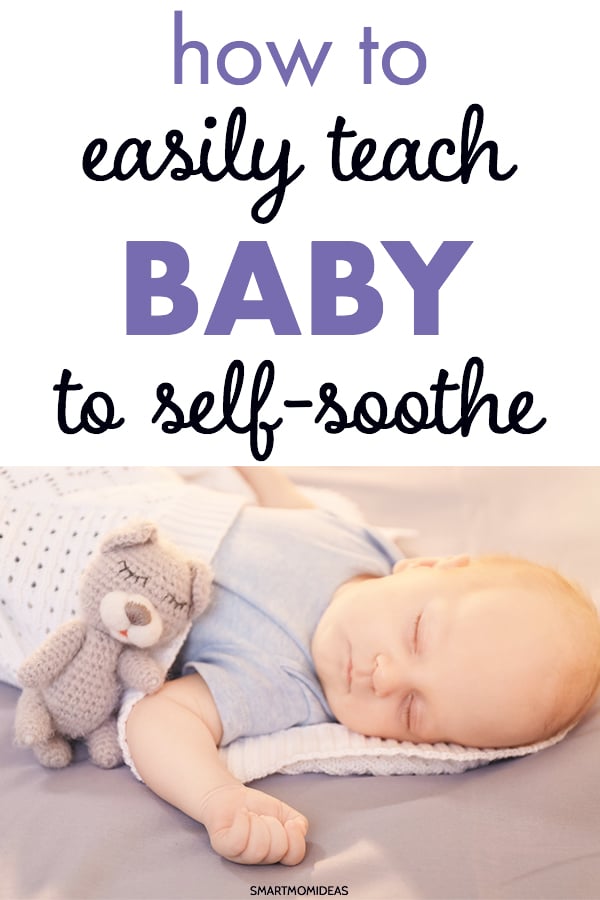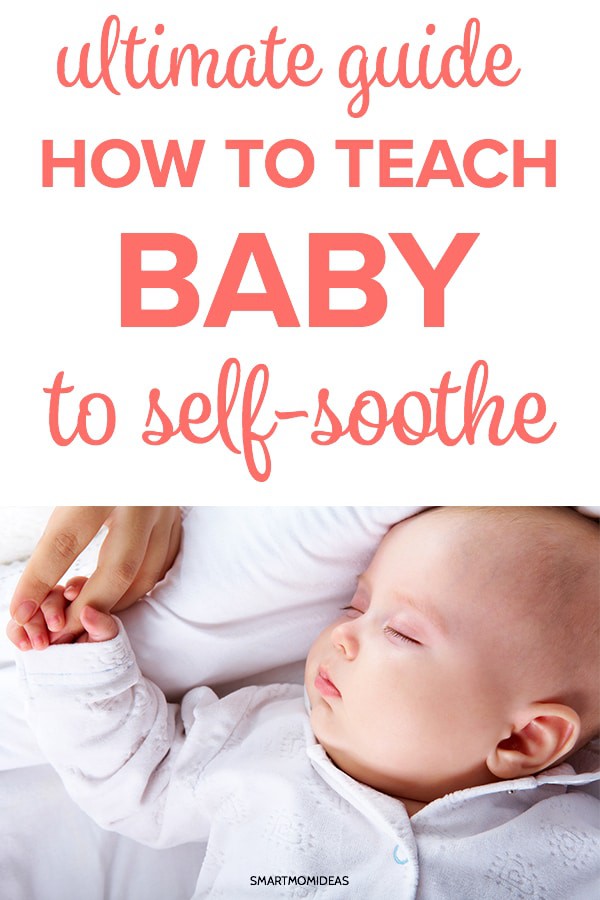Learn how easily it is to teach your baby to self-soothe

How can such an adorable little bundle of joy cause such stress and havoc on your sleep life?
I’m sure as a parent this has happened to you at least once: you are chatting with a group of other parents and someone has to brag about how their little one is sleeping peacefully through the night.
Meanwhile your infant is torturing you with sleep deprivation.
Teaching your baby to self-soothe can not only help THEM get more sleep during the night (resulting is a less cranky baby during the day) but can also help YOU to get more sleep and save your sanity at the same time.
But first, what exactly is self-soothing?
Simply put, self-soothing is when your child is able to stop crying and put themselves to sleep without having to be comforted by a caregiver. The unfortunate part is it can involve a lot of crying, at least at first.
But rest assured, this does not make you a bad parent and it will not last forever.
As a first time parent, teaching your baby to self-soothe can be difficult on both of you at first.
It can some with some major mommy guilt. In this post I’ll cover some tactics to use while teaching your baby to self-soothe and how you can avoid feeling like a terrible parent.
I’ll also share with you how my twins self-soothed themselves to sleep.
The Benefits of Self-Soothing
Self-soothing is a skill that your baby can learn and it will carry with them into early childhood and even into adulthood.
You probably already realize the benefits of your baby being able to self-soothe, the most obvious one is that everyone is going to get more sleep. But what are some of the benefits beyond that?
Beyond just getting more sleep, teaching your baby to self-soothe can also help out any other caregivers in your baby’s life.
You can not be with them 24-hours a day to pick them up and cuddle them whenever they are upset. And that’s ok!
You don’t want to have to worry about trying to have a date night while your little one is doing nothing by screaming while at the babysitter’s.
When your infant can effectively learn to self-soothe, they then grow into toddlers that can effectively self-soothe, then growing children that can self-soothe.
This means that even though they might throw a temper tantrum, they will then be able to self-soothe and calm down quicker than children who don’t have this skill.
Self-soothing is a skill that goes well beyond childhood and is beneficial into adulthood.
So when your little one is sitting there screaming, just remember that it won’t last forever and you’re benefiting them in the long term as well.
When babies learn to self-soothe it can help them to return to a deeper sleep if they are already in a light-sleeping state.
When your baby is getting more and deeper sleep for longer periods of time they will ultimately be more rested, leading to a happier baby then they are awake.
This is also a great tactic to get your baby to learn to sleep through the night (which is really the ultimate goal here right?!)
Once your baby has learned to self-soothe they will be able to manage their emotions better when they are playing or learning how to share as well.
They will also be able to remain happier longer without having to be constantly entertained and will be able to play by themselves for longer periods of time.
And of course, a happy baby means a happy mama!
Creating a Self-Soothing Environment
My post about fastest colic relief hacks has some of the environmental factors I am going to talk about here.
Environmental factors can be a big player in how well your baby is able to self-soothe.
It can be very difficult to self-soothe when there is a very noisy or harsh environment, which can lead to overstimulation. When it comes to bed time, make sure you have a good, calming routine in place.
Something that involves low light, soft noises, and of course, a few snuggles.
Having a white noise machine can work wonders in providing that gentle background noise and to drown out any other noises in the house that might disturb baby.
If your baby is teething or just always seem to have their hands in their mouths, teething mittens can work wonders!
These are made of soft, food grade silicone and fit perfectly in baby’s mouth for endless enjoyment.
If your baby will allow it, swaddling is a great way to help them self-soothe.
This makes them feel like they are being snuggled without actually having to be held.
This is actually one of the tactics that I used with my twins. I would swaddle them, turn on the white noise machine, and made a “mom shirt lovey” and placed it in their crib without a pacifier.
If you are looking for some amazing smart technology to help get your baby to self-soothe, there are many smart bassinets that can help to calm your baby.
If your goal is to self-soothe to help get baby to sleep through the night, work on transitioning them to being in their crib on their own, if they are not already.
Start by letting them fall asleep in your arms if that is what they normally do, such as when breastfeeding.
Then transition to them laying next to you, in a bassinet, and finally in their crib. It is ok to let baby have some toys in the crib to play with to help them self-soothe.
Just be sure that they don’t present any choking hazards or can cause overstimulation with lots of lights and sounds.
Your Role as a Parent/Caregiver
One of the biggest things with self-soothing is that you, the parent or caregiver, have to remove yourself from the situation. This means don’t hold your baby until they fall asleep and also try to avoid giving them a bottle or cup until they fall asleep.
Although it can be difficult when your little one is crying, it is important to be consistent with your actions.
Try not to pick them up every time they become upset or seem distressed.
You should be able to recognize your baby’s various cries.
There is generally a big difference between a cry that is just seeking attention and a cry that means they are hurt or in danger. Crying is your baby’s only way of communicating, so they tend to do it a lot, even when they don’t actually need anything other than your attention.
If your baby is showing signs that they just want attention, try talking to them and let them know what you are doing rather than just holding them.
“It’s ok honey, mommy needs to finish making dinner then we can play.”
Talking to your baby reassures them that you are near, even if they can’t see you, and comforts them, even without picking them up.
You also need to be able to listen to your baby when they are giving you cues that they are upset or tired. You can also start off with letting them self-soothe for shorter periods of time and gradually extend the time periods.
This will help them to develop that self-soothing behavior and they will gradually need you to help them calm down less and less.
It is up to your child to ultimately determine when they are at the right age to self-soothe. If you have tried and have been unsuccessful, all is not lost.
Try again in a month or so. You need to be consistent and let your baby know that you are still there for them.
Try to keep baby occupied with toys and other things that don’t require you to be right there with them.
My Process of Teaching My Twins to Self-Soothe
As I mentioned I would use white noise, swaddling and my mom shirt lovey to help my twins associate those items with sleep cues.
I didn’t attempt to self-soothe until my twins were much older – 6-9 months.
At this time I would use a bottle for my son and breastfed my daughter to help them get sleepy and placed them in their crib together.
Then I would place my hand on them and stay there until they slept.
This didn’t always work (many times I did go back to picking them up and trying again), but over time I was able to give the their bottle/milk much earlier than bedtime and do a night routine like bath, story and goodnight kisses and snuggles.
Each baby is different and they have different needs. Because I had twins and they slept in the same crib, I feel they also used each other to self-soothe.
How to Tell if Your Baby is Trying to Self-Soothe
There are many things that an infant can do to try and soothe themselves. Keep an eye out for some of these clues and encourage your baby to use these strategies when they become upset.
- Sucking on a pacifier, fingers, thumb, or their fist
- Rubbing their eyes (someone’s tired!)
- Snuggling with their favorite toy or blanky
- Rubbing something soft in between their fingers
- Rubbing their hair or head
- Rocking themselves from side to side
- Making humming or cooing sounds
If you see that your baby is becoming upset, try to encourage them to use these tactics rather than just picking them up and snuggling them right away. I know it can be difficult, but they will learn in time.
But when should you start teaching your baby to self-soothe?
There is no exact pre-determined age, each child is different and has different needs. Experts suggest the earliest you should start is around 4 months of age.
Although if you do not work with your child on self-soothing tactics within the first year, the toddler years and beyond might get a little rough. Six to nine months seems to be the sweet spot for many (it was for me!).
Teaching your baby to self-soothe takes time, so don’t rush it. Be patient with yourself and with your little one.






Leave a Reply